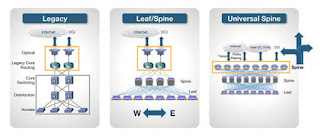Arista takes aim at core router market with Universal Spine
The concept of using switching infrastructure as a replacement for a core router is certainly nothing new. Years ago, vendors like Foundry Networks and Force10 tried to make the case but were unsuccessful in their attempts. Although the switches were beefy and had massive port density they were missing some key features such as MPLS support, the ability to support a full Internet routing table and carrier class resiliency. From an economic perspective, the cost per port on a switch is about one-tenth what it is on a router, so there is a financial argument to be made but the products just didn’t have the technical chops to hang with big routers.
Arista Networks is now taking a shot at this market again but is taking a significantly different approach to the market. Arista is attempting to disrupt the core router market by replacing the big boxes with a distributed spine, similar to the way the company disrupted the legacy data center switching market. Spine-Leaf configurations are well accepted today in big data centers and cloud providers but this wasn’t the case just a few years ago as there was a certain religion around big chassis deployed in multiple tiers.
Arista’s Universal Spine architecture is built on the same concept but moves the spine into the core. The solution is enabled by Arista’s new 7500 R Series switch/router platform specifically designed for cloud providers and large enterprises looking to build next generation data centers. While switches can be very robust and be loaded with router like features, the fact is they aren’t routers and that’s where the switch vendors failed in the past. Arista’s 7500 R is the first combined switch and router that uses a switch-like architecture but has been beefed up with router features. Key attributes of the Universal Spine are:
- Total fabric capacity of a whopping 115 Tbps
- Up to 432 wirespeed 100 Gig ports
- Flexible port speeds of 1/10/25/40/50/100 Gig
- Lossless forwarding using virtual output queues
- Arista FlexRoute technology that delivers over a million routes, more than enough for an Internet routing table with MPLS, Segment Routing and EVPN.
- NEBS compliance - a key certification for service providers
- Programmable traffic engineering with support for 128,000 MPLS, GRE, VXLAn and IP-in-IP tunnels
- Hitless upgrades
- Millisecond network convergence
- N+1 fabric resiliency
- 36 QSFP ports with a choice of 10/25/40/50/100 Gig
- 36 40 Gig ports with flexible combinations of 10 Gig and up to 6 ports of 100 Gig
- 48 10 Gig SFP+ and 2 100 Gig QSFP
Arista’s Universal Spine creates an interesting option to a traditional core router. In practicality I really don’t expect to see tier 1 or 2 network operators jumping at it until it’s proven. Telcos tend to be highly risk adverse and want to see technology used in other markets first. Arista quoted NetFlix in its press release and big cloud providers should prove to be an excellent test bed for Universal Spine. It’s an interesting vision and now it’s time for Arista to prove it works.


No comments:
Post a Comment